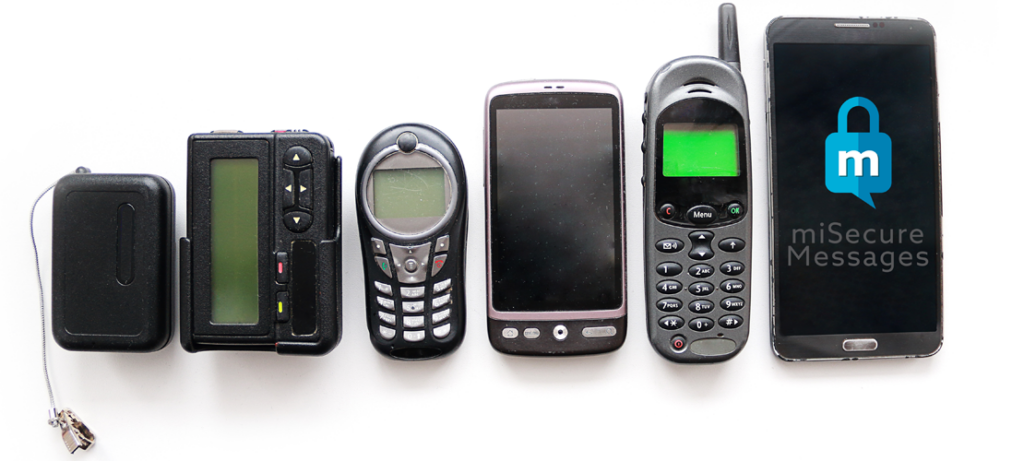In this post, we look into the past, present, and future of healthcare communication technology. Technology has evolved significantly over time, especially when it comes to the ways in which we communicate. In the healthcare industry, the pager has played a big role in keeping healthcare teams connected, and it still does today.
However, secure and HIPAA compliant messaging technologies have emerged within the last decade and are now competing with the traditional pager. This month, we’re covering the evolution of healthcare communication technology by looking at the tools used in the past, what is used in the healthcare industry today, and what we see to be the future of healthcare communication.
Past: Pagers
The first one-way radio communication system was deployed by the Detroit Police Department in 1928, which relied on radio to deliver one-way communication to police cars. The first telephone pager was patented in 1949 by Al Gross, and at the time, it was not called a pager and was only available for use by doctors in New York in the 1950s.
Motorola coined the term ‘pager’ in 1959 when it called its personal radio communications product a pager after the company managed to combine elements of Motorola’s walkie-talkie and car radio technologies into the first transistorized pager.
From 1964 to the mid-1980s, pagers evolved from the tone-only pager to the alphanumeric display pager. These pagers allowed the recipient to receive, but not send messages. It wasn’t until the late-1990s that Motorola introduced the two-way pager with a QWERTY keyboard, so message recipients could respond to the page directly from the device. Many major hospitals and health systems still employ two-way paging, but one-way pagers remain more popular.
Present: Pagers and Secure B.Y.O.D Messaging
According to a study by the Journal of Hospital Medicine, 49 percent of respondents said they receive PCR (patient care–related) messages most commonly by pager. Additionally, a study by BMJ Quality and Safety found that the paging rate and volume have not decreased in 25 years despite new emerging technologies.
However, that’s not to say secure BYOD (bring your own device) messaging platforms have not been implemented. In fact, according to a study by Black Book Market Research, 94 percent of physicians and 90 percent of hospital leaders, respectively, believe the effective use of mobile technology in the regulated healthcare industry is improving patient safety and outcomes.
The need to maintain secure communications and ensure patients receive essential care, especially as cybersecurity threats persist and evolve, have prompted the need to shift to a secure messaging solution. Because of this, 96 percent of hospitals, from the study, budgeted/invested in comprehensive clinical communication platforms before the close of 2018.
Today’s healthcare communication landscape consists of both pager and secure messaging platform use. However, it’s our recommendation that healthcare systems shift from using pagers to solely using secure messaging platforms, like Amtelco Secure Messages.
Future: Secure B.Y.O.D Messaging
Though pagers are still a highly used communication tool in the healthcare industry, hospitals that use pagers are at risk of data breaches, financial loss, and communication inefficiencies, which can lead to wasted time and, in some cases, the loss of lives.
Under HIPAA regulations, hospitals still using pagers are prohibited to send any protected health information (PHI) via a pager, unless the messages are encrypted and the identity of the user can be verified. If PHI needs to be communicated, the individual must call to relay that information over the phone. Such inefficient communications result in wasting billions of dollars every year.
Upgrading to a secure messaging platform that utilizes end-to-end encryption, like Amtelco Secure Messages, can ensure PHI, in the form of text, photo, video, and audio, remains secure and hospital staff communicates quickly and effectively all via your personal (B.Y.O.D) or company-provided device. This eliminates the need to call and relay information over the phone.
Because one-way pagers can only receive messages, recipients are unaware of who is contacting them, the reason(s) why, and the level of urgency, which can lead to issues with prioritization and wasted time to gain more information. According to a study by the Ponemon Institute, it was determined that hospital-based physicians and nurses wasted 46 minutes a day on average by using pagers and beepers.
To combat inefficient communication, messaging platforms like Amtelco Secure Messages allow users to send end-to-end encrypted messages instantly to individuals or groups within their healthcare teams. Unlike traditional pagers, messages are marked with timestamps to ensure accountability among team members and show when messages are delivered, read, completed, and deleted. In addition to fast and efficient instant messaging, the app allows users to set their status — at lunch, in a meeting, in/out of office, making rounds, etc. — to further prevent wasted time.
Just as technology continues to evolve, the future of healthcare communication will as well, providing a more efficient and secure solution for healthcare teams. We have already begun to see the shift from pagers to secure messaging platforms in the United Kingdom, as the Health and Social Care Secretary of the National Health Service has ordered the removal of pagers for non-emergency communications by the end of 2021.





